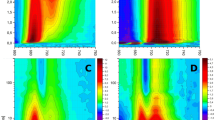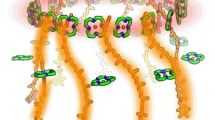Abstract
Induction of the bacteriochlorophyll fluorescence under rectangular shape of intense laser diode illumination (1 W cm−2, 808 nm) was measured over wide time range from 10 μs to 4 s in whole cells, chromatophore and isolated reaction center protein of wild type and carotenoid-less mutant (R-26.1) of purple photosynthetic bacterium Rhodobacter sphaeroides. While the antenna-containing species showed large and positive variable fluorescence (F v) to initial fluorescence (F 0) (F v/F 0 ∼ 4.5 in whole cells), the isolated RC had negative change (F v/F 0 ∼ −0.6) during photochemistry. In chromatophore from R-26.1, only seven times higher rate was measured than in isolated reaction center under identical experimental conditions. The enhancement effect of large antenna on the rate of photochemistry in chromatophore was partially compensated by the favorable pigment absorption properties in isolated RC. The transition from membrane bound to isolated form of the reaction center was probed by titration of zwitterionic detergent LDAO in chromatophore, and at 0.03% LDAO concentration, sharp change of the variable fluorescence was observed. The sudden drop was explained by the formation of LDAO micelles. After the photochemical phase, additional change of fluorescence yield could be observed in isolated RC considered as manifestation of long-living conformations of the trapped redox states of the protein characterized by non-exponential kinetics. Strong support was provided for use of the fluorescence induction to track structural and conformation changes at their earliest phases in chromatophores and isolated reaction centers.






Similar content being viewed by others
Abbreviations
- BChl:
-
Bacteriochlorophyll
- Bpheo:
-
Bacteriopheophytin
- D:
-
External electron donor to P+
- F 0 :
-
Initial fluorescence intensity
- F v :
-
Variable fluorescence intensity
- LDAO:
-
N,N-dimethyldodecylamine-N-oxide
- LH I and LH II:
-
Light harvesting complexes I and II, respectively
- P:
-
Bacteriochlorophyll dimer
- PSII:
-
Photosystem II of higher plants
- Q:
-
Quinone acceptor
- QA :
-
Primary quinone acceptor
- QB :
-
Secondary quinone acceptor
- RC:
-
Reaction center protein
- UQ10 :
-
Ubiquinone-50
References
Andréasson U, Andréasson L-E (2003) Characterization of a semi-stable, charge-separated state in reaction centers from Rhodobacter sphaeroides. Photosynth Res 75:223–233
Agostiano A, Milano F, Trotta M (2005) Trapping of a long-living charge separated state of photosynthetic reaction centers in proteoliposomes of negatively charged phospholipids. Photosynth Res 83(1):53–61
Borisov AYu, Godik VI (1972) Energy transfer to the reaction centers in bacterial photosynthesis. II. Bacteriochlorophyll fluorescence lifetimes and quantum yields for some purple bacteria. J Bioenerg Biomembr 3(6):515–523
Breton J, Lavergne J, Wakeham MC, Nabedryk E, Jones M (2007) The unusually strong hydrogen bond between the carbonyl of Q(A) and his M219 in the Rhodobacter sphaeroides reaction center is not essential for efficient electron transfer from Q(A)(−) to Q(B). Biochemistry 46:6468–6476
Cogdell RJ, Isaacs NW, Freer AA, Howard TD, Gardiner AT, Prince SM, Papiz MZ (2003) The structural basis of light harvesting in purple bacteria. FEBS Lett 555:35–39
Cser K, Vass I (2007) Radiative and non-radiative charge recombination pathways in Photosystem II studied by thermoluminescence and chlorophyll fluorescence in the cyanobacterium Synechocystis 6803. Biochim Biophys Acta 1767:233–243
De Klerk H, Govindjee, Kamen MD, Lavorel J (1969) Age and fluorescence characteristics in some species of athiorhodaceae. Proc Natl Acad Sci USA 62:972–978
Dau H (1994) Molecular mechanisms and quantitative models of variable Photosystem II fluorescence. Photochem Photobiol 60(1):1–23
Filus Z, Laczkó G, Wraight CA, Maróti P (2004) Delayed fluorescence from photosynthetic reaction center measured by electronic gating of the photomultiplier. Biopolymers 74:92–95
Gast P, Hemelrijk PW, van Gorkom HJ, Hoff AJ (1996) The association of different detergents with the photosynthetic reaction center protein of Rhodobacter sphaeroides R26 and the effects on its photochemistry. Eur J Biochem 239:805–809
Gerencsér L, Maróti P (2007) Fluorescence induction reveals organization of antenna and reaction center in photosynthetic bacteria. Acta Biol Szeged 51(1):27–32
Goushcha AO, Manzo AJ, Kharkyanen VN, Grondelle R, Scott GW (2004) Light-induced equilibration kinetics in membrane-bound photosynthetic reaction centers: nonlinear dynamic effects in multiple scattering media. J Phys Chem B 108:2717–2725
Herrmann KW (1962) Non-ionic-cationic micellar properties of dimethyldodecylamine oxide. J Phys Chem 66:295–300
Ishikita H, Knapp EW (2005) Control of quinone redox potentials in photosystem II: electron transfer and photoprotection. J Am Chem Soc 127:14714–14720
Kálmán L, Maróti P (1997) Conformation-activated protonation in reaction centers of the photosynthetic bacterium Rhodobacter sphaeroides. Biochemistry 36:15269–15276
Katona G, Snijder A, Gourdon P, Andréasson U, Hansson Ö, Andréasson L-E, Neutze R (2005) Conformational regulation of charge recombination in a photosynthetic bacterial reaction center. Nat Struct Mol Biol 12:630–631
Kautsky H, Hirsch A (1931) Neue Versuche zur Kohlensäureassimilation. Naturwissenschaften 48:964
Koblizek M, Shih JD, Breitbar SI, Ratcliffe EC, Kolber ZS, Hunter CN, Niederman RA (2005) Sequential assembly of photosynthetic units in Rhodobacter sphaeroides as revealed by fast repetition rate analysis of variable bacteriochlorophyll a fluorescence. Biochim Biophys Acta 1706:220–231
Klafter J, Shlesinger MF (1986) On the relationship among three theories of relaxation in disordered systems. Proc Natl Acad Sci USA 83:848–851
Lavergne J, Trissl HW (1995) Theory of fluorescence induction in photosystem II: derivation of analytical expressions in a model including exciton-radical-pair equilibrium and restricted energy transfer between photosynthetic units. Biophys J 68:2474–2492
Lazar D (2006) The polyphasic chlorophyll a fluorescence rise measured under high intensity of exciting light. Funct Plant Biol 33:9–30
Maróti P, Lavorel J (1979) Intensity- and time-dependence of the carotenoid triplet quenching under rectangular illumination in Chlorella. Photochem Photobiol 29:1147–1151
Maróti P, Wraight CA (1988) Flash-induced H+ binding by bacterial photosynthetic reaction centers: comparison of spectrometric and conductometric methods. Biochim Biophys Acta 934:314–328
McMahon BH, Müller JD, Wraight CA, Nienhaus GU (1998) Electron transfer and protein dynamics in the photosynthetic reaction center. Biophys J 74:2567–2587
Mueh F, Rautter J, Lubitz W (1997) Two distinct conformations of the primary electron donor in reaction centres from Rhodobacter sphaeroides revealed by ENDOR/TRIPLE-spectroscopy. Biochemistry 36:4155–4162
Müller NJC (1874) Beziehungen zwischen assimilation, absorption und fluorescenz im chlorophyll des lebenden blattes. Jahrb Wiss Bot 9:42–49
Ogrodnik A, Hartwich G, Lossau H, Michel-Beyerle ME (1999) Dispersive charge separation and conformational cooling of P+H −A in reaction centers of Rb. sphaeroides R26: a spontaneous emission study. Chem Phys 244:461–478
Osváth Sz, Laczkó G, Sebban P, Maróti P (1996) Electron transfer in reaction centers of Rhodobacter sphaeroides and Rhodobacter capsulatus monitored by fluorescence of the bacteriochlorophyll dimer. Photosynth Res 47:41–49
Osváth Sz, Herényi L, Závodszky P, Fidy J, Köhler G (2006) Hierarchic finite level energy landscape model. J Biol Chem 281(34):24375–24380
Papageorgiou GC, Govindjee (eds) (2004) Chlorophyll fluorescence: a signature of photosynthesis. Advances in photosynthesis and respiration. Kluwer Academic Publishers, Dordrecht
Roszak AW, Howard TD, Southall J, Gardiner AT, Law CJ, Isaacs NW (2003) Crystal structure of the RC-LH1 core complex from Rhodopseudomonas palustris. Science 302:1969–1972
Strop P, Brunger AT (2005) Refractive index-based determination of detergent concentration and its application to the study of membrane proteins. Protein Sci 14:2207–2211
Trissl H-W (1996) Antenna organization in purple bacteria investigated by means of fluorescence induction curves. Photosyth Res 47:175–185
Trissl H-W (1999) Theory of fluorescence induction. An introduction. http://www.biologie.uni-osnabrueck.de/biophysik/trissl/Teaching/fi.PDF
Van Grondelle R, Duysens LN (1980) On the quenching of the fluorescence yield in photosynthetic systems. Plant Physiol 65:751–754
Van Mourik F, Reus M, Holzwarth AR (2001) Long-lived charge-separated states in bacterial reaction centers isolated from Rhodobacter sphaeroides. Biochim Biophys Acta 1504:311–318
Vredenberg WJ, Duysens LNM (1963) Transfer of energy from bacteriochlorophyll to a reaction centre during bacterial photosynthesis. Nature (Lond) 197:355–357
Wraight CA (2004) Proton and electron transfer in the acceptor quinone complex of bacterial photosynthetic reaction centers. Front Biosci 9:309–327
Wraight CA, Clayton RK (1974) The absolute quantum efficiency of bacteriochlorophyll photooxidation in reaction centers. Biochim Biophys Acta 333:246–260
Zankel KL, Reed DW, Clayton RC (1968) Fluorescence and photochemical quenching in photosynthetic reaction centers. Proc Natl Acad Sci USA 61:1243–1249
Acknowledgments
This work was supported by NKTH-OTKA (K-67850), MTA-CNR and TéT. Thanks are due to Dr. L. Gerencsér and Ms. R. Kékesi for their help in the simulation and preliminary measurements.
Author information
Authors and Affiliations
Corresponding author
Additional information
Regional Biophysics Conference of the National Biophysical Societies of Austria, Croatia, Hungary, Italy, Serbia, and Slovenia.
Rights and permissions
About this article
Cite this article
Maróti, P. Kinetics and yields of bacteriochlorophyll fluorescence: redox and conformation changes in reaction center of Rhodobacter sphaeroides . Eur Biophys J 37, 1175–1184 (2008). https://doi.org/10.1007/s00249-008-0300-5
Received:
Revised:
Accepted:
Published:
Issue Date:
DOI: https://doi.org/10.1007/s00249-008-0300-5




